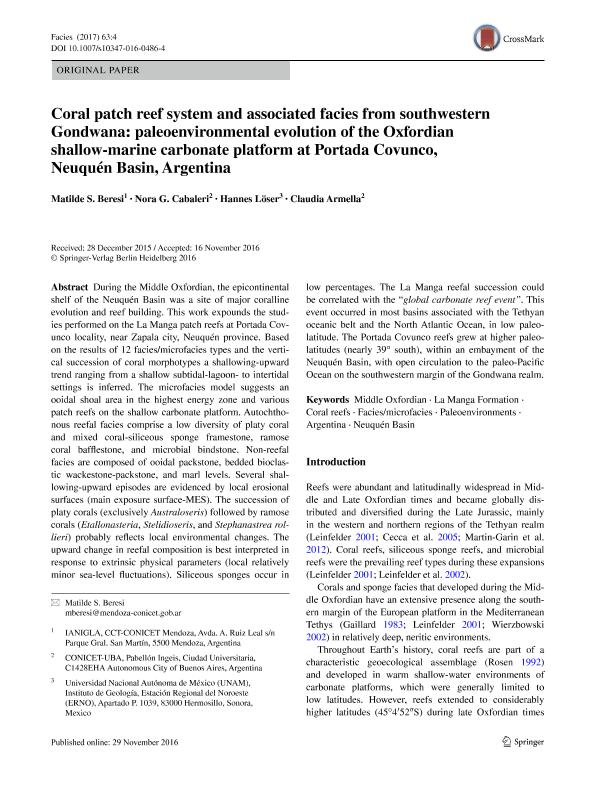Mostrar el registro sencillo del ítem
dc.contributor.author
Beresi, Matilde Sylvia

dc.contributor.author
Cabaleri, Nora Graciela

dc.contributor.author
Loser, Hannes
dc.contributor.author
Armella, Claudia

dc.date.available
2018-04-20T18:09:59Z
dc.date.issued
2016-01
dc.identifier.citation
Beresi, Matilde Sylvia; Cabaleri, Nora Graciela; Loser, Hannes; Armella, Claudia; Coral patch reef system and associated facies from southwestern Gondwana: paleoenvironmental evolution of the Oxfordian shallow‑marine carbonate platform at Portada Covunco, Neuquén Basin, Argentina; Springer; Facies; 63; 1-2016; 2-22
dc.identifier.issn
0172-9179
dc.identifier.uri
http://hdl.handle.net/11336/42890
dc.description.abstract
During the Middle Oxfordian, the epicontinental shelf of the Neuquén Basin was a site of major coralline evolution and reef building. This work expounds the studies performed on the La Manga patch reefs at Portada Covunco locality, near Zapala city, Neuquén province. Based on the results of 12 facies/microfacies types and the vertical succession of coral morphotypes a shallowing-upward trend ranging from a shallow subtidal-lagoon- to intertidal settings is inferred. The microfacies model suggests an ooidal shoal area in the highest energy zone and various patch reefs on the shallow carbonate platform. Autochthonous reefal facies comprise a low diversity of platy coral and mixed coral-siliceous sponge framestone, ramose coral bafflestone, and microbial bindstone. Non-reefal facies are composed of ooidal packstone, bedded bioclastic wackestone-packstone, and marl levels. Several shallowing-upward episodes are evidenced by local erosional surfaces (main exposure surface-MES). The succession of platy corals (exclusively Australoseris) followed by ramose corals (Etallonasteria, Stelidioseris, and Stephanastrea rollieri) probably reflects local environmental changes. The upward change in reefal composition is best interpreted in response to extrinsic physical parameters (local relatively minor sea-level fluctuations). Siliceous sponges occur in low percentages. The La Manga reefal succession could be correlated with the “global carbonate reef event”. This event occurred in most basins associated with the Tethyan oceanic belt and the North Atlantic Ocean, in low paleolatitude. The Portada Covunco reefs grew at higher paleolatitudes (nearly 39° south), within an embayment of the Neuquén Basin, with open circulation to the paleo-Pacific Ocean on the southwestern margin of the Gondwana realm.
dc.format
application/pdf
dc.language.iso
eng
dc.publisher
Springer

dc.rights
info:eu-repo/semantics/openAccess
dc.rights.uri
https://creativecommons.org/licenses/by-nc-sa/2.5/ar/
dc.subject
Middle Oxfordian
dc.subject
La Manga Formation
dc.subject
Coral Reefs
dc.subject
Facies/Microfacies
dc.subject
Paleoenvironments
dc.subject
Argentina
dc.subject
NeuquÉN Basin
dc.subject.classification
Meteorología y Ciencias Atmosféricas

dc.subject.classification
Ciencias de la Tierra y relacionadas con el Medio Ambiente

dc.subject.classification
CIENCIAS NATURALES Y EXACTAS

dc.title
Coral patch reef system and associated facies from southwestern Gondwana: paleoenvironmental evolution of the Oxfordian shallow‑marine carbonate platform at Portada Covunco, Neuquén Basin, Argentina
dc.type
info:eu-repo/semantics/article
dc.type
info:ar-repo/semantics/artículo
dc.type
info:eu-repo/semantics/publishedVersion
dc.date.updated
2018-04-13T20:01:27Z
dc.identifier.eissn
1612-4820
dc.journal.volume
63
dc.journal.pagination
2-22
dc.journal.pais
Alemania

dc.journal.ciudad
Berlin
dc.description.fil
Fil: Beresi, Matilde Sylvia. Consejo Nacional de Investigaciones Científicas y Técnicas. Centro Científico Tecnológico Conicet - Mendoza. Instituto Argentino de Nivología, Glaciología y Ciencias Ambientales. Provincia de Mendoza. Instituto Argentino de Nivología, Glaciología y Ciencias Ambientales. Universidad Nacional de Cuyo. Instituto Argentino de Nivología, Glaciología y Ciencias Ambientales; Argentina
dc.description.fil
Fil: Cabaleri, Nora Graciela. Consejo Nacional de Investigaciones Científicas y Técnicas. Oficina de Coordinación Administrativa Ciudad Universitaria. Instituto de Geocronología y Geología Isotopica. Universidad de Buenos Aires. Facultad de Ciencias Exactas y Naturales. Instituto de Geocronología y Geología Isotópica; Argentina
dc.description.fil
Fil: Loser, Hannes. Universidad Nacional Autónoma de México; México
dc.description.fil
Fil: Armella, Claudia. Consejo Nacional de Investigaciones Científicas y Técnicas. Oficina de Coordinación Administrativa Ciudad Universitaria. Instituto de Geocronología y Geología Isotopica. Universidad de Buenos Aires. Facultad de Ciencias Exactas y Naturales. Instituto de Geocronología y Geología Isotópica; Argentina
dc.journal.title
Facies

dc.relation.alternativeid
info:eu-repo/semantics/altIdentifier/doi/http://dx.doi.org/10.1007/s10347-016-0486-4
dc.relation.alternativeid
info:eu-repo/semantics/altIdentifier/url/https://link.springer.com/article/10.1007/s10347-016-0486-4
Archivos asociados
